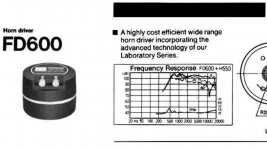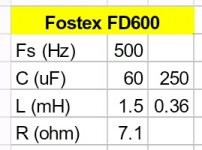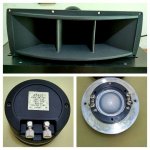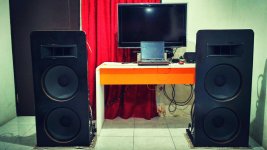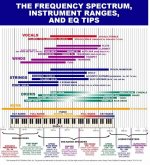I'm building an open baffle speaker with twin Eminence 15A Alphas, a Fostex FE168es mid and a yet-to-be-selected tweeter.
Q1. For best sound quality, should the woofers be parallel or put in series? (So the impedance would be halved or doubled, respectively)
Q2. To follow your method, what adjustments must I make to the other woofer driver properties?
Thanks.
Great tutorial. I'm itching to start.
Doug
Q1. For best sound quality, should the woofers be parallel or put in series? (So the impedance would be halved or doubled, respectively)
Q2. To follow your method, what adjustments must I make to the other woofer driver properties?
Thanks.
Great tutorial. I'm itching to start.
Doug
Your amp may prefer to provide voltage, or to supply current. If one way sounds better, it's likely to be subtle. Is there something specific you are concerned about?Q1. For best sound quality, should the woofers be parallel or put in series? (So the impedance would be halved or doubled, respectively)
The concern I would have is integrating their radiation pattern into the room. When this doesn't play well with the listening axis response the speaker can become difficult to cross, let alone to get the system right.Q2. To follow your method, what adjustments must I make to the other woofer driver properties?
Electrically, if you use two drivers in series then treat them as one, doubling resistances and inductances, and halving capacitances.
Your amp may prefer to provide voltage, or to supply current. If one way sounds better, it's likely to be subtle. Is there something specific you are concerned about?
The concern I would have is integrating their radiation pattern into the room. When this doesn't play well with the listening axis response the speaker can become difficult to cross, let alone to get the system right.
Electrically, if you use two drivers in series then treat them as one, doubling resistances and inductances, and halving capacitances.
Hi AllenB
Thanks for the prompt response.
I have a Yamaha M70 and a Quad 303. I could use either of these, or I could tri-amp, using some class D units.
I note your concern about the radiation pattern, but I guess I'll just have to hear it and judge if it is acceptable. The room is LARGE (hence opting for dual woofers), with a skillion ceiling, sloping down from R 16' to L 9', as viewed from the listening position.
I asked about the dual woofer arrangement out of sheer lack of knowledge.
cheers
Doug
If you cross below, say, 300Hz then they should be acting as one. Once you go significantly higher than this then their vertical directivity may begin closing a tad earlier than for horizontally. It's difficult to predict whether this will be an issue without measurement.dual woofer arrangement
If you cross below, say, 300Hz then they should be acting as one. Once you go significantly higher than this then their vertical directivity may begin closing a tad earlier than for horizontally. It's difficult to predict whether this will be an issue without measurement.
Thanks. I'll try that.
I read elsewhere that paralleling the woofers means the cost of the XO inductors would be cheaper. If there's nothing else either way, then that sounds the way to go.
cheers
Doug
I'm awaiting for my resistor too arrive to measure driver impedance.. meanwhile I felt in love with old fathioned Vu meter...

Awailable at Alie...
Will the vue meter impact the cross over calculus ?

Awailable at Alie...
Will the vue meter impact the cross over calculus ?
I'm playing with my first XO trial, tested on my horn tweeter fostex fd600. I have some inductors value : 0.22, 0.39, 0.82 mH and many capacitor value. I have tried caps filter only up to 5.6uf and i find that the vocal is very dominant. tried 2nd order which is currently use 6.8uf & 0.82mH but i hear annoying resonance.
with tweeter Fs around 500Hz, i tried to make notch filter and use 0.39mH - 220uf (bipolar cap) - 7ohm
now it's more enjoyable, but i'm thinking to play with notch filter LC value. what if i increase L value and reduce C value to get same 500Hz target? is there any variable like Q in notch filter? which one is better from my attach 2 combination, 60uF & 1.5mH or 220uF & 0.39mH where R is the same 7R.
thanks
with tweeter Fs around 500Hz, i tried to make notch filter and use 0.39mH - 220uf (bipolar cap) - 7ohm
now it's more enjoyable, but i'm thinking to play with notch filter LC value. what if i increase L value and reduce C value to get same 500Hz target? is there any variable like Q in notch filter? which one is better from my attach 2 combination, 60uF & 1.5mH or 220uF & 0.39mH where R is the same 7R.
thanks
Attachments
the impedance plot shows a peak @ ~500Hz indicating a resonance.
But there is also a peak in the response plot @ ~ 700Hz.
I think you should be crossing well above that response peak, or taking steps to EQ the response to nearer flat till you get down to your chosen crossover frequency.
I wonder if a 2kHz cross might be better, if the mid can extend cleanly to fill the new gap.
But there is also a peak in the response plot @ ~ 700Hz.
I think you should be crossing well above that response peak, or taking steps to EQ the response to nearer flat till you get down to your chosen crossover frequency.
I wonder if a 2kHz cross might be better, if the mid can extend cleanly to fill the new gap.
@andrew
yes the target is 2kHz based on fostex recommended xo with 12" woofer, but i have no EQ available.
testing some iteration of parts combination last night, it was very interesting. below some scenario:
HP : 5.2uF & 0.6mH.
Notch : 220uf & 0.6mH (0.6R dcr), tried resistor 10R, 3R, 1R and best result to my ear without any resistor. then I tried to change HP inductor 0.4mH & 0.8mH and no significant difference.
also tried in another notch 60uF & 1.5mH with various resistor value, the result is not good.
finally settle on HP 5.2uF &0.6mH with notch 220uf & 0.6mH (0.6R dcr)
my testing is only by connecting the horn tweeter and play Yao Si Ting album, which is the most sibilance recording and many SSSS that really hurt the ears if tweeter is not correct.
15" woofer has 0.8mH in series to reduce the peak above 5kHz and reduce some vocal. without inductor, 15" vocal is too dominant.
now they woofer and tweeter blend nicely in open baffle
yes the target is 2kHz based on fostex recommended xo with 12" woofer, but i have no EQ available.
testing some iteration of parts combination last night, it was very interesting. below some scenario:
HP : 5.2uF & 0.6mH.
Notch : 220uf & 0.6mH (0.6R dcr), tried resistor 10R, 3R, 1R and best result to my ear without any resistor. then I tried to change HP inductor 0.4mH & 0.8mH and no significant difference.
also tried in another notch 60uF & 1.5mH with various resistor value, the result is not good.
finally settle on HP 5.2uF &0.6mH with notch 220uf & 0.6mH (0.6R dcr)
my testing is only by connecting the horn tweeter and play Yao Si Ting album, which is the most sibilance recording and many SSSS that really hurt the ears if tweeter is not correct.
15" woofer has 0.8mH in series to reduce the peak above 5kHz and reduce some vocal. without inductor, 15" vocal is too dominant.
now they woofer and tweeter blend nicely in open baffle
Attachments
indeed i'm using the horn H550, but i'm still missing below 200Hz, lower 15" is not connected yet. i'm still finishing 24dB filter + bass boost.
btw does notch filter impact on HP slope? as my finding, the level of suppressing vocal by notch filter is more noticeable instead of adding inductor on HP. I might test the same filter on Alpair 10p this weekend to find out what is the main contain on 2kHz above.
it seems that normal human voice range less than 2kHz, some article said mariah carey can reach higher octave, i might need to find her lossless album just for testing
btw does notch filter impact on HP slope? as my finding, the level of suppressing vocal by notch filter is more noticeable instead of adding inductor on HP. I might test the same filter on Alpair 10p this weekend to find out what is the main contain on 2kHz above.
it seems that normal human voice range less than 2kHz, some article said mariah carey can reach higher octave, i might need to find her lossless album just for testing
Attachments
"some article said mariah carey can reach higher octave, i might need to find her lossless album just for testing"
So ... you're not listening to music then?..
not a fan of her
I grew up by buying cassette tape ( no cd or vinyl here) on pop music. now after building my own audio chain, downloading their lossless album just find out how bad pop recording compared to "audiophile" grade one.
but listening to music sometimes do not require any fancy playback tools, but when you evaluate your audio chain and mostly diy, recording quality is more important than the music.
If you are running this horn to 200Hz, it may have resonance issues at the lower end? When you cross to a 15" driver you will probably arrive at a higher crossover point.indeed i'm using the horn H550, but i'm still missing below 200Hz, lower 15" is not connected yet.
It can be difficult to judge without the sub-200Hz content. With a properly smooth speaker it is possible to judge sibilance with the bass removed but when a speaker is being first set up there are usually too many issues at once.
If you can get the response the same either way, then it should sound the same. Sometimes it happens that either can work. The filter I would choose is the one that creates the response you want and that would be based on the response you start with and how you percieve the problems with it that need to be straightened out.the level of suppressing vocal by notch filter is more noticeable instead of adding inductor on HP.
Sometimes I try different filters. One could do the job better, or simpler, use less components, be less critical of values or uses a value I have on hand. It is not easy to make two different filters achieve the same response without measurement, it can be a complicated arrangement and not easy to hear.
A notch filter can be a good tool but resist an excessive damping figure when it doesn't give the results you expect. Sometimes what is described as sibilance, or phaseyness, can be peaks and dips in the response. If these exist it is best to find out why and look at the options. A notch filter offers the sharpness to deal with these but can create such issues if mistuned.
As for your tweeter impedance peak compensating notch filter, this is one of the better choices when experimenting. In most cases it is 'set and forget', although changing a horn can affect the peak.
I discovered this thread yesterday and designed two crossovers for two different 5 inch Dayton midbass drivers with Dayton silkies, drivers unseen. Great thread for us to do mental exercise designing loudspeakers. I might actually build one of them someday but I have two Tang Band full range arriving tomorrow and I will build a TABAQ first and maybe a second TABAQ or a regular vented fullrange.
Thanks for the information of designing the crossover.
Thanks for the information of designing the crossover.
The TABAQ has an inductor and resistor (RL) to tweak the response around the baffle size (the baffle could also be extended/rounded on the outside to improve this transition).
I find many full range drivers respond to a careful notch around their breakup region using an RLC network.
As well as treble level adjustment and bass Q adjustment, these are some examples of passive component usage on a single way system.
I find many full range drivers respond to a careful notch around their breakup region using an RLC network.
As well as treble level adjustment and bass Q adjustment, these are some examples of passive component usage on a single way system.
- Home
- Loudspeakers
- Multi-Way
- Introduction to designing crossovers without measurement
